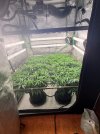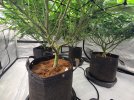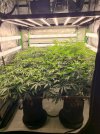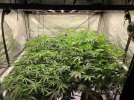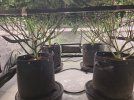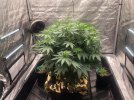Kinda weird results but to be expected. Center under canopy 50 ppfd. Around 1 foot from the edges of my tent under the canopy I'm getting about 200-250 ppfd. Where the light intersects down low I got 450. Up top at the highest bud side 650. I mean the lights are putting out some power and I can definitely turn them up from here.
Cannabis will thrive at a PPFD of 1000µmol. If you're running at 650±, your crop size could well be reduced by about 33% vs what it would be at 1kmol, all other factors being the same.
I created this table based on the data presented in the cited research.

I would suggest that you increase PPFD on the canopy until you hit the light saturation point. From what I can determine*, it takes about 30 days for a cannabis plant to reach its maximum light levels. And, unlike the conventional wisdom on gradually turning up the dimmer, if you have a "mature" cannabis plant, the plant should be able to get to the "800-1000µmol, strain dependent" level very quickly, in jumps of 200µmol per day, for example. Keep in mind - it's
very hard to cause damage to a cannabis plant when using an LED.
I'm not averse to adding lights to maximize average PPFD. In my last grow, in which I unwisely tried to grow two plants, I'm used a Growcraft X flower light which was supplemented by Spider GlowR80 660nm lights suspended between the bars of the Growcraft, as well as a Vipar XS1500 for the little plant, and a semi-retired Mars SP3000 for the "front row" of the big plant ("Donna").

*I've never been able to find any research on this but this is the behavior I've seen in my grows over the past three years and I believe that theory would be supported because the primary function of the vegetative state is to grow a plant that's maximally capable of supporting the flowering stage.
As always, I if anyone can cite a source or share their research on this, I'd love to read it.

